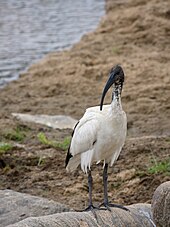משתמש:בנצי/ארגז חול 22: מגלן אפריקני מקודש
The African Sacred Ibis (Threskiornis aethiopicus) is a species of ibis.
תיאור[עריכת קוד מקור | עריכה]
גובהו של פרט בוגר הוא כ-68 ס"מ; גופו ארוך ועטוי כולו פלומה לבנה, מלבד ??? כהות על ???. ראשו ועורפו הקרחים, ??? העבה והעקום (?) ורגליו, שחורים. כנפיו הלבנות מציגות שוליים (?) שחורים במהלך תעופה.
בית גידול ותפוצה[עריכת קוד מקור | עריכה]
Description[עריכת קוד מקור | עריכה]
An adult individual is 68 cm long with all-white body plumage apart from dark plumes on the rump. The bald head and neck, thick curved bill and legs are black. The white wings show a black rear border in flight. Sexes are similar, but juveniles have dirty white plumage, a smaller bill and some feathering on the neck.

This bird is usually silent, but occasionally makes some croaking noises, unlike its vocal relative, the Hadeda Ibis.
Habitat and distribution[עריכת קוד מקור | עריכה]
A wading bird of the ibis family, Threskiornithidae, the Sacred Ibis breeds in sub-Saharan Africa, southeastern Iraq, and formerly in Egypt, where it was venerated and often mummified as a symbol of the god Thoth. The African Sacred Ibis occurs in marshy wetlands and mud flats, both inland and on the coast. It will also visit cultivation and rubbish dumps.
Reproduction[עריכת קוד מקור | עריכה]

The bird nests in tree colonies, often with other large wading birds such as herons. It builds a stick nest often in a baobab and lays 2-3 eggs.
Diet[עריכת קוד מקור | עריכה]
It feeds on various fish, frogs, small mammals, reptiles and smaller birds as well as insects. It may also probe into the soil with its long bill for invertebrates such as earthworms.
As an introduced species[עריכת קוד מקור | עריכה]
The African Sacred Ibis has been introduced into France, Italy, Spain, Taiwan, and the United States (S. Florida).
The introduced and rapidly growing populations in southern Europe are seen as a potential problem, since these large predators can devastate breeding colonies of species such as terns. They also compete successfully for nest sites with Cattle and Little Egrets. The adaptable Ibises supplement their diet by feeding at rubbish tips, which helps them to survive the winter in these temperate regions.
Conservation[עריכת קוד מקור | עריכה]
The African Sacred Ibis is one of the species to which the Agreement on the Conservation of African-Eurasian Migratory Waterbirds (AEWA) applies.
Sacred Ibis in myth and legend[עריכת קוד מקור | עריכה]

Venerated and often mummified by Ancient Egyptians as a symbol of the god Thoth, the Ibis was according to Herodotus and Pliny the Elder also invoked against incursions of winged serpents. Herodotus' account follows as thus:
"There is a region moreover in Arabia, situated nearly over against the city of Buto, to which place I came to inquire about the winged serpents: and when I came thither I saw bones of serpents and spines in quantity so great that it is impossible to make report of the number, and there were heaps of spines, some heaps large and others less large and others smaller still than these, and these heaps were many in number."
"The region in which the spines are scattered upon the ground is of the nature of an entrance from a narrow mountain pass to a great plain, which plain adjoins the plain of Egypt;
"and the story goes that at the beginning of spring winged serpents from Arabia fly towards Egypt, and the birds called ibises meet them at the entrance of this country and do not suffer the serpents to go by but kill them. On account of this deed it is (say the Arabians) that the ibis has come to be greatly honored by the Egyptians, and the Egyptians also agree that it is for this reason that they honor these birds." In more mythical stories, it was also said that the flies that brought pestilence died immediately upon propitiatory sacrifices of this bird.[1]
References[עריכת קוד מקור | עריכה]
- ^ Pliny, Natural History Book X Chapter 41)
- Barlow, Wacher and Disley, Birds of The Gambia. ISBN 1-873403-32-1
External links[עריכת קוד מקור | עריכה]
- Sacred Ibis videos, photos & sounds on the Internet Bird Collection
- Invasive Species Factsheet African Sacred Ibis on DAISIE European Invasive Alien Species Gateway
